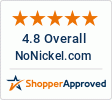While the impact of food on nickel allergy is still under medical scrutiny, there is legitimate concern that the nickel content in some food may be exacerbating contact dermatitis and eczema symptoms. As dermatologists continue their research into the role of diet in controlling nickel allergy problems, the nickel allergic public needs answers.
Before experimenting with a low nickel diet, allergy sufferers should schedule an appointment with a dermatologist or allergist who specializes in nickel allergy, to obtain a definitive medical diagnosis and professional recommendations. In most cases, no diet changes will be suggested.
However, it appears that for a very small population of allergy sufferers, a low nickel diet can help. Research seems to indicate a causal relationship between the ingestion of high nickel foods and eczema in this group of individuals.
Undertaking a low nickel diet is difficult because nickel content varies depending on the level of nickel in the soil where the food item is grown and whether it is processed or stored using nickel-laden metals. Typically the following dietary items have a higher level of nickel: grains such as whole wheat, rye, oat, millet, and buckwheat, legumes including peas, lentils, peanuts, soya beans, and chickpeas, soy products, canned foods, and dried fruits.
For those concerned about the upcoming holidays and nickel consumption, the good news is that turkey, other poultry, and meats contain low levels of nickel and are considered safe foods on a low nickel diet. This news clears the traditional Christmas ham, too, so enjoy!
NoNickel owner, Michael Dow, suggests that most nickel sensitive people can tolerate a day of “forbidden foods”, so holiday meals should be a time of relaxing with family and friends rather than worrying about dietary restrictions. However, if one’s allergist or dermatologist recommends following this diet, there are many low nickel options. In addition to meat and poultry, studies generally concur that cheese, milk, yogurt, beets, spinach, apples, strawberries, and another holiday staple - fresh cranberries- are among the low nickel options. Other studies recommend eating a diet high in iron and supplementing with vitamin C to reduce the absorption of nickel in the body.
After sitting down for the Thanksgiving feast, some minds start turning toward holiday shopping! Keep in mind that with the selection of products offered at NoNickel.com, it is now easier than ever to live comfortably with nickel allergy. Even more importantly, avoiding nickel is essential to prevent worsening symptoms or even the potential development of systemic dermatitis. We can think of no better way to show your care for a nickel allergic loved one's well-being than to purchase products that will allay their health concerns.
Lots of new products have been introduced this year, with a special emphasis on Nickel Free Gift Sets. Containing two belts and either a handcrafted leather wallet or nickel free dichroic glass post earrings, these sets will be shipped in an organza bag, making them immediately gift-ready!
For shoppers who are unsure of the gift recipient’s belt size, the Nickel Free Dress Belt Combo offers one black nickel free belt and one brown nickel free belt. These belts come with instructions for perfectly simple sizing, up to a size 44” (112 cm).
Nickel free dichroic glass jewelry is a mesmerizing gift, as the handcrafted dichroic glass has stunning color and designs. The dichroic glass is designed and fired in North Carolina artisans' studio then handcrafted into the beautiful earrings now offered. Of course they have been awarded the Certified Nickel Free™ seal of approval that they will never test positive for nickel.
Trusting The Nickel Allergy Experts at NoNickel is the best way to enjoy the magic of the holidays without the worry of nickel allergy symptoms!















